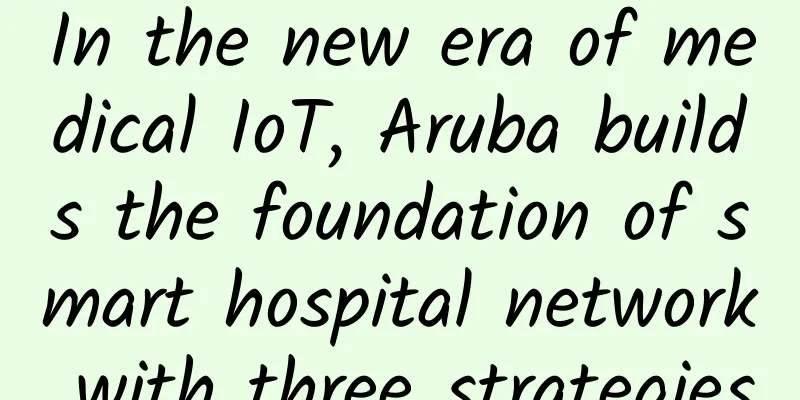In the new era of medical IoT, Aruba builds the foundation of smart hospital network with three strategies

|
After making an appointment on the mobile phone APP and signing in, you can find the corresponding department through the hospital's navigation system. After checking the report on your mobile phone, you can get the medicine number after paying the fee on your mobile phone or automatic terminal, and then quickly get the medicine through the fully automatic medicine collection system of the smart pharmacy. After leaving the hospital, you can also update the condition on the mobile phone APP, and the doctor can also use the APP to understand the patient's condition at any time... These medical consultation scenarios, which were only imagined many years ago, are now gradually becoming a reality along with the process of digital transformation of hospitals. Driven by the COVID-19 pandemic, the digital transformation of the medical industry has continued to accelerate, with trends such as the gradual maturity of Internet hospitals, the acceleration of the construction of Internet of Things hospitals, and the cloudification of medical software becoming prominent. The policy level has also continued to release positive news, such as the requirement to build a "three-in-one" smart hospital and the release of the "Interconnection Standardization Maturity Assessment Program (2020 Edition)". These have provided guarantees for promoting the standardization of medical and health service and management systems. Medical IoT has gradually become the core of hospital digital transformation. IoT construction can help hospitals improve operational efficiency and achieve refined management. The core businesses of hospitals, such as outpatient, inpatient, management, logistics, etc., have released strong demand for IoT technology. As a leader in wired and wireless networks, Aruba has been deeply involved in the field of digital transformation in the medical industry for many years. Several years ago, it added IoT access capabilities to the AP architecture, and many mature solutions and products have been successfully applied to many large tertiary hospitals. In the new era of hospital IoT construction, Aruba has taken three measures based on its product advantages and years of accumulation to provide strong support for hospital information operations. The first step: unified management and convenient maintenance At present, the construction of the Internet of Things in many hospitals is still in its early stages. Most hospitals lack the construction standards and technical routes of the Internet of Things. When they start to build the medical Internet of Things, they often only consider meeting business needs. Basically, they are mainly single application scenarios, independent use, and independent applications. The closed loop is not open. As more and more medical Internet of Things application systems are built, the data interaction between them becomes more and more complicated. Different systems use different Internet of Things technologies, which can easily lead to incompatibility between Internet of Things base stations/gateways and terminals. In addition to the difficulty of unified management, fragmented construction also brings difficulties to later maintenance and increases costs. In this regard, Aruba AP provides a unified operation and maintenance management platform, allowing campus network and IoT management to be "two-pronged", and integrates various IoT applications, supports the conversion and access of various IoT communication protocols (Wi-Fi 6, BLE, Zigbee, EnOcean, LoRaWAN, etc.), and realizes unified management based on the status, location, and business process of sensors, simplifying operations and reducing costs. Aruba AP + EnOcean gateway can connect cloud platforms, smart devices, acquisition and transmission equipment, various sensors, etc., and one operating system can achieve visualization, which can not only simplify the management of IoT, but also allow the network team to quickly troubleshoot the cause of the fault to solve problems and obstacles in network operation. It adopts automation technology that integrates intelligent technologies such as machine learning, which can help medical institutions reduce the management burden, improve operational efficiency, and avoid long waiting time for equipment and delay patient treatment. Tip 2: High flexibility and scalability The result of fragmented construction is that the entire system architecture presents a complex mesh network topology. With the increase of IoT devices and the enrichment of application scenarios, the problem of passive, uncontrollable and unsustainable construction of hospital-wide medical IoT will become increasingly prominent. Aruba's solution is highly flexible and scalable. All products are Wi-Fi Alliance certified, have built-in IoT chips (Bluetooth, Zigbee, etc.), and support USB expansion and Mesh bridging, avoiding the cost, complexity and potential vulnerabilities of gateways and IoT stacked networks. It can meet the needs of the surging number of users and mobile devices, as well as cloud-based applications and services, and solve the problem of difficulty in integrating and collaborating IoT in different scenarios built in hospitals. It can be applied to different places such as hospital outpatient lobbies, pharmacies, inpatient areas, and wards. Aruba continues to improve the scalability of its IoT solutions and recently launched an IoT operations dashboard, providing an open platform similar to the APP Store for all IoT applications, helping third-party ecosystem partners to easily integrate IoT applications into Aruba Central and provide them to users for download and use. The third trick: safe and reliable to eliminate hidden dangers According to a report released by SAM Seamless Network in April this year, a billion IoT devices were attacked last year. The IoT involves terminals, edges, platforms, and applications, and there are many devices with a wide range of exposure. The threat posed by attacks will be much greater than attacks on individual personal computers or mobile devices. Whether it is a ransomware attack or a data leak, it will cause huge losses to hospitals and may also threaten the lives of patients. Therefore, security vulnerabilities of IoT devices are also one of the most worrying issues for hospitals. Aruba's medical IoT solution ensures network security. Aruba APs integrate a Trusted Platform Module (TPM) to securely store credentials and keys to protect the security of all IoT devices (from medical devices to surveillance cameras). With zero-trust security, Aruba ensures that all medical devices, users, and things are analyzed and assigned the correct network access rights. Aruba ClearPass Policy Manager's role-based access policies enable IT and security teams to use appropriate roles and implement relevant access rights anywhere in the network (wired or wireless network infrastructure, branch offices, or campuses) based on best practices. After the device is identified, it automatically obtains the correct access control policy and is isolated from other devices through Aruba's dynamic isolation function to maximize network security protection. In the era of smart healthcare, Aruba is committed to providing flexible, secure and reliable medical IoT solutions to help medical institutions build a network foundation and accelerate the pace of digital transformation, thereby providing patients with a better medical service experience. |
<<: Five ways 5G will change retail
>>: Practicing ESG, Shengye continues to promote sustainable development of supply chain technology
Recommend
Juniper Networks' Shaowen Ma: The best SDN controller for cloud computing
[51CTO.com original article] The interview with M...
Full coverage of prefecture-level cities! China has built the world's largest 5G network
[[373230]] In the year hit by the COVID-19 pandem...
Let’s talk about the new features of HTTP/3. Why did you choose to use the UDP protocol?
[[399228]] This article is reprinted from the WeC...
[11.11] 66 Cloud VPS 20% off for monthly payment and 40% off for annual payment, Hong Kong/US/Korea/Japan data centers available
666clouds has launched a special promotion during...
HTTP knowledge points, a must-know in the exam
Detailed introduction to http HTTP is the abbrevi...
What are the new features of HTTP/2 compared to HTTP/1.1? How to solve head-of-line blocking and header compression?
[[398710]] This article is reprinted from the WeC...
How will the emergence of 5G affect AI federated learning?
As development teams scramble to build AI tools, ...
The "5G messages" of the three major operators are about to be commercialized. What impact will it have on SMS and WeChat?
At the 5G Message High-level Forum of the China I...
If you still don’t understand HTTPS after reading this article, come to me!
As an aspiring programmer, it is necessary to und...
The three major telecom operators have begun to deploy 5G messaging on a large scale
5G messaging, which is seen by the industry as We...
Working together: Two ways Wi-Fi and 5G can coexist
WBA: Wi-Fi and 5G coexist at the physical layer o...
DogYun (Dog Cloud) New Year's Day 20% off on all dynamic clouds, 10% off on classic clouds, 100 yuan off for independent servers per month, 50% off on lucky wheel draws
DogYun (狗云) has released a New Year's Day dis...
Friendhosting Spring Promotion, VPS at least 45% off for half a year starting from 7.6 euros
Friendhosting is a Bulgarian hosting company esta...
The AI dual competitions will enter the final round in August. Huawei invites you to witness the birth of the champions of the DIGIX Geek Artificial Intelligence Campus Innovation Competition and the Algorithm Elite Competition!
[51CTO.com original article] This summer, two eve...
Ministry of Industry and Information Technology: my country breaks through 5G key technologies and commercial equipment will be launched before the end of the year
According to CCTV reports, at the 2018 5G Summit ...









